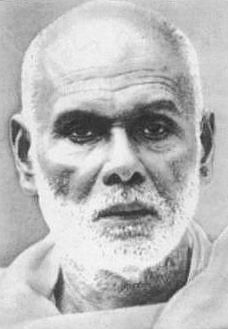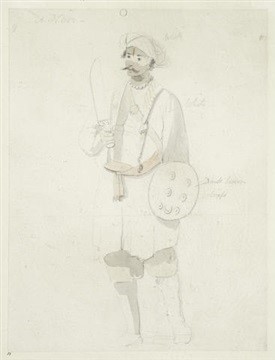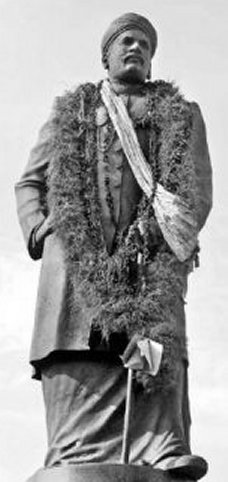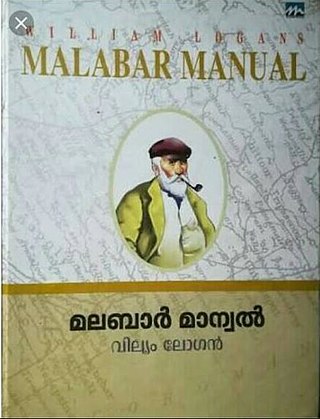
Sree Narayana Guru was a philosopher, spiritual leader and social reformer in India. He led a reform movement against the injustice in the caste-ridden society of Kerala in order to promote spiritual enlightenment and social equality. A quote of his that has become popular: "one caste, one religion, and one god for all men". He is the author of the Advaita poem Daiva Dasakam, which is one of the most used poem in Kerala for community prayer.

The Nair also known as Nayar, are a group of Indian Hindu castes, described by anthropologist Kathleen Gough as "not a unitary group but a named category of castes". The Nair include several castes and many subdivisions, not all of whom historically bore the name 'Nair'. These people lived, and continue to live, in the area which is now the Indian state of Kerala. Their internal caste behaviours and systems are markedly different between the people in the northern and southern sections of the area, although there is not very much reliable information on those inhabiting the north.

Mahatma Ayyankali was an Indian politician, prominent social reformer, educator, economist, lawmaker, and revolutionary leader. He worked for the advancement of the oppressed people in the princely state of Travancore. His struggle resulted in many changes that improved the socio-political structure of Kerala. His determined and relentless efforts changed the lives of Dalits.

Thunchaththu Ramanujan Ezhuthachan was a Malayalam devotional poet, translator and linguist. He was one of the prāchīna kavithrayam of Malayalam literature, the other two being Kunchan Nambiar and Cherusseri. He has been called the "Father of Modern Malayalam", the "Father of Modern Malayalam Literature", and the "Primal Poet in Malayalam". He was one of the pioneers of a major shift in Kerala's literary culture. His work is published and read far more than that of any of his contemporaries or predecessors in Kerala.

The Temple Entry Proclamation was issued by Maharaja Chithira Thirunal Balarama Varma on November 12, 1936. The Proclamation abolished the ban on the backward and marginalised communities, from entering Hindu temples in the Princely State of Travancore, now part of Kerala, India.

Govindan Parameswaran Pillai, also known as Barrister G. P. Pillai, was a freedom fighter, social reformer, barrister, journalist, and publisher. He established the first English language newspaper in South India, The Madras Standard. He drafted the Malayali Memorial in 1891. Pillai is the only Malayali whom Mahatma Gandhi has mentioned in his autobiography. He regularly wrote columns in various newspapers. Pillai stood against autocratic governance in Travancore and promoted civil rights and equal opportunity among all classes.
The caste system in Kerala differed from that found in the rest of India. While the Indian caste system generally divided the four-fold Varna division of the society into Brahmins, Kshatriyas, Vaishyas and Shudras, in Kerala, that system was absent. The Malayali Brahmins formed the priestly class and Nairs formed Aristocracy, rank immediately below malayali Brahmins. Brahmins labeled all other castes as "Sat-sudra", "Shudra" and "Avarna" based on their origin and ritual rank. The exception to this were the military elites among the Samantha Kshatriyas and the Nairs, who were ritually promoted to the status of Kshatriya by means of the Hiranyagarbha ceremony. This was done so that the Samanthans and Nairs could wield temporal ruling powers over the land, as they constituted the aristocratic class.

Pandit Karuppan was a poet, dramatist, and social reformer who lived in Kerala, India.

Padmanabhan Palpu was a physician from the Kingdom of Travancore who served as a chief medical officer of Mysore State.

The Ezhavas are a community with origins in the region of India presently known as Kerala, where in the 2010s they constituted about 23% of the population and were reported to be the largest Hindu community. The Malabar Ezhava group have claimed a higher ranking in the Hindu caste system than do the others, although from the perspective of the colonial and subsequent administrations they were treated as being of similar rank.

The Sree Narayana Dharma Paripalana Yogam (S.N.D.P) is a social service organization that has been representing the Ezhava community from the Indian state of Kerala since 1903.

Vayaleri kunhikannan Gurukkal-(Vagbhatananda) was a Hindu religious leader and Reform movement in British India. He was the founder of the Atmavidya Sangham, which was fundamentally a group of professionals and intellectuals who sought change, and also the Uralungal Labour Contract Co-Operative Society.

North Malabar refers to the geographic area of southwest India covering the state of Kerala's present day Kasaragod, Kannur, and Wayanad districts, and the taluks of Vatakara and Koyilandy in the Kozhikode District of Kerala and the entire Mahé Sub-Division of the Union Territory of Puducherry. Traditionally North Malabar has been defined as the northern portion of the erstwhile Malabar District which lies between Chandragiri River and Korapuzha River. The region between Netravathi River and Chandragiri River, which included the portions between Mangalore and Kasaragod, are also often included in the term North Malabar, as the Kumbla dynasty in the southernmost region of Tulu Nadu, had a mixed lineage of Malayali Nairs and Tuluva Brahmins.

Kiryathil Nair or Kiriyath Nair is a Kshatriya Nair subcaste, of martial nobility, having performed the functions of Kshatriyas in Kerala, India. This subcaste was among the highest-ranking subcastes of the Nair community along with Samantan Nairs with whom they share a close history. They constituted the ruling elites (Naduvazhi) and feudal aristocrats (Jenmimar) in the regions of Malabar and Cochin in present-day Kerala, India, and have traditionally lived in ancestral homes known as Tharavads and Kovilakams.

Vaikom Satyagraha, was a nonviolent agitation for access to the prohibited public environs of the Vaikom Temple in the Kingdom of Travancore. Kingdom of Travancore was known for its rigid and oppressive caste system. The campaign, led by Congress leaders T. K. Madhavan, K. Kelappan K. P. Kesava Menon, George Joseph, E. V. Ramasamy "Periyar" and was noted for the active support and participation offered by different communities and a variety of activists.After the intervention of Mahatma Gandhi, a compromise was reached with Regent Sethu Lakshmi Bayi who released all those arrested and opened the north, south and west public roads leading to Vaikom Mahadeva Temple to all castes. Bayi refused to open the eastern road. The compromise was criticized by E. V. Ramasamy "Periyar" and some others. Only in 1936, after the Temple Entry Proclamation, was access to the eastern road and entry into the temple allowed to the backward castes.
Sanulla Makti Thangal was the renaissance leader of Muslim society in Malabar of British India and the advocate of western education among the backward community of Mappila. He was notable as the first Muslim scholar to bring various reforms in Kerala Muslim Society

The Malabar Manual was an 1887 publication by William Logan, a Scottish officer of the Madras Civil Service under the British Government, appointed the Collector of Malabar. The work was commissioned by the Government of Madras, and originally published in two volumes. The book was originally named as Malabar later renamed as Malabar Manual by Kerala gazetters department. Logan spent about 20 years in Kerala as an acting resident collector and later judge under the British East India Company. The Malabar Manual is a collection of information and assumptions obtained from his travels and studies. Malabar Manual is a veritable book of accurate informations in relation to the geography, mountains and rivers, geology, climate and natural phenomena, flora and fauna, the people, their economy, ethnography, caste and occupations, manners and customs, religion, language, literature, the state of education and such other details. As the administrative head of the district he had access to a vast resources and he also had a dedicated stream of resourceful natives working under him, whose contributions have also gone into the making of Malabar Manual. Revised editions and Malayalam translations are available today.
The legend of Cheraman Perumals is the medieval tradition associated with the Cheraman Perumals of Kerala. The sources of the legend include popular oral traditions and later literary compositions. The time of origin of the legend is not known to scholars. It seems the legend once had a common source well known to all Kerala people.

Kannur, formerly known in English as Cannanore, Arabic as Kannanur, and Portuguese as Cananor, is a city and a Municipal Corporation in North Malabar region, state of Kerala, India. It is the largest city in North Malabar, which is the northernmost region of Kerala. It is sometimes identified Kolathunadu, which was ruled by the Kolathiris. In the 12th and 13th centuries there was trade with Persia and Arabia.














